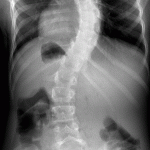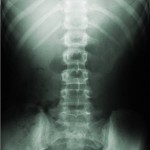When viewed from the side, the spine should have curves.
But when viewed from the front or back, the spine should run straight up and down the middle of the back.
Scoliosis is a progressive condition in which the spine develops curves when viewed from the front or back. Scoliosis can affect children and adults, and there are different types of scoliosis.
- Scoliosis (Back view)
- Normal Spine X-ray (Back View)
The most common type of scoliosis is called “Idiopathic Scoliosis”. Idiopathic mean that the underlying cause of the scoliosis is unknown. Although there is increasing evidence that there is a genetic link in most cases. Idiopathic scoliosis occurs most frequently in adolescents and is therefore called “Adolescent Idiopathic Scoliosis” (AIS). AIS develops in early adolescence and is found more frequently in girls than boys. In girls early signs of AIS can usually be seen around 11 to 12 years of age. Boys with AIS usually start to show early signs around 13 to 14 years of age.
While is is most common to see idiopathic scoliosis in adolescents, it can occur in younger children aged 3 to 10 years (Juvenile Scoliosis) and in babies (Infantile Scoliosis). These early onset types of idiopathic scoliosis have a very serious potential for progression (worsening) and require treatment as soon as possible.
Adults that were diagnosed with a adolescent idiopathic scoliosis when they were younger can have problems as they get older. Most commonly they can suffer from chronic lower back pain. However in some cases their scoliosis can slowly worsen often between 1 to 3 degrees per year. In older adulthood a previously stable scoliosis can begin to worsen because of spinal degeneration. This is called “Adult Degenerative Scoliosis”. It is also possible for a person that has never had a scoliosis before to develop a new scoliosis due to spinal degeneration and advancing age. This is called “De Novo Scoliosis” . De Novo scoliosis is often associated with chronic lower back pain.
There are many other conditions that can cause a “non-idiopathic scoliosis”. These conditions are often syndromes that effect the soft tissues of the body such as Marfans syndrome or neurological conditions such as syringomyelia. Other causes can include tumors of the spine or other serious pathologies. While serious pathologies are rarely the cause of a scoliosis it is important to seek advice from a health professional specialising in scoliosis so that these causes can be ruled out.

